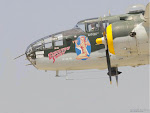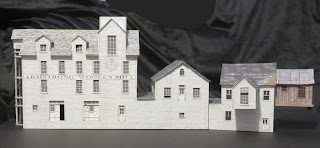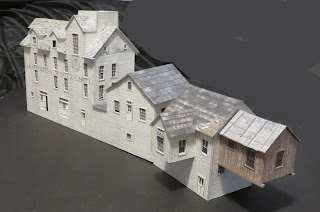These structure and others will be placed along a road that will climb along the backdrop of my Scots' Landing module. I'll build the hill and the road on the bench and then place it on the layout.
I'll need a few more houses and a medium-sized factory to fill out this four-foot chunk of HO scale landscape.
The green house on the right is Clever Models' "Small Chicago House" (S14). The other two are kitbashed versions of the same kit. The porch on the left uses fine cloth mesh for window screen.
This building is scratch built from a photo on the Internet. I widened it by adding the vertical row of windows on the left. The side walls are Clever Models' "Cream City Brick" texture sheet. I haven't decide what kind of business this will house so there is no sign yet. Roof details include a scatchbuilt hatch, some scrap lumber, and a sand barrel and shovel from Fine Scale Miniatures.
The boarding house is scratch-built from photos of one of the buildings from the Builders In Scale "Waterfront" kit. The photos were from
Vilius Bileisis' amazing blog, The storefront will probably end up being a cafe but I am so far undecided. Walls, windows, doors, and shutters came from Vilius' photos. The shingles and chimney are from Clever Models.
The stone & wood barn is scratch-built from a photo on the Internet. It might be someone's craftsman kit, I don't remember where I found it. The stone walls are from Textures.com, the wood walls, roof, doors and windows are from the Randsburg Barbershop kit by Paper Creek, now available free from
Papermodelers.com. All were modified in Photoshop. This will be a cabinet shop but I have not yet decided on a name.
The grocery store is a scratchbuilt copy of a model photo I found somewhere on the Internet. Wall texture, windows, and doors are from Clever Models' texture collections. The image in the large windows and the wall signs are images from the Web. I'll put some produce crates in the entryway when they arrive from Model Tech Studios.




















































